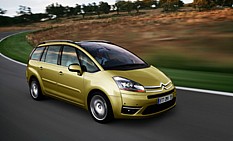Review
 |
 |
 |
CITROËN obviously sees a bright future in MPVs.
The existing Xsara Picasso is Citroën’s biggest seller among fleets, thanks in the main to spectacular Motability sales, and, with the introduction of the C4 Picasso, the French firm can now claim a four-model MPV line-up: the Xsara, C8, C4 Picasso seven-seater and now the five-seat version.
So the seven-seat model will now be called the C4 Grand Picasso, with the new five-seat one taking the C4 Picasso name for itself and around 70% of C4 Picasso sales in total. All clear? So what’s different?
Firstly, and obviously, the number of seats is now five. The new C4 Picasso also gets far more radical styling. The frontal design might be much the same as its seven-seat relative but from the A-pillar back the C4 Picasso is a much sportier-looking car.
There’s a neat kinked window line, a sloping rear roof and smart new tail lights. The new look is pitched to attract younger, more style-conscious buyers and is also likely to appeal to customers not just of other compact MPVs but also those looking at regular hatchbacks.
Unlike them, the Picasso offers all the practicalities you’d expect of a vehicle in the compact MPV class. The individual rear seats fold and slide and the boot offers between 500 and 1,734 litres of load space, with that area accessed either by the regular hatchback or via the opening rear window.
Passenger space is impressive, with excellent leg and shoulder room in the rear. In addition, all passenger seats offer Isofix child seat fittings. The interior is bathed in light too, with the C4 Picasso’s huge Visiospace windscreen and large side glass making for a bright and airy interior.
The dashboard is identical to its seven-seat relative. This makes for a good combination of tactile and expensive-looking plastics, smart interior lighting and Citroën’s fixed-hub steering wheel. The latter allows Citroën not only to maximise airbag performance – there are seven as standard – but also to messily cluster audio, trip computer, telephone and cruise control buttons around the wheel.
Picassos fitted with the automatic or EGS (Electronic Gear System) automated manual also feature paddle-shifters fixed to the steering column.
Those two self-shifting transmissions, as well as a regular five-speed manual, are offered with a combination of four engines.
The diesel range consists of 1.6 and 2.0-litre HDI units with 110bhp and 138bhp respectively and a petrol line-up offering a choice of 127bhp 1.8-litre or 143bhp 2.0-litre engines. Citroën expects around two-thirds of fleet C4 Picassos to be fitted with diesels, the anticipated best seller being the 1.6 HDI in either SX or VTR+ trim levels.
The EGS system is likely to appeal to those conscious of CO2 emissions, the automated manual reducing CO2 output from 155g/km in the 1.6 HDI to 150g/km while also decreasing fuel consumption by 2mpg.
There’s no denying that Citroën has produced an impressive and stylish compact MPV. Its style should help with residuals: Citroën already claims a retained value performance of more than 35% for the C4 Picasso’s Grand relative and is expecting a similar performance for its new five-seater.
Behind the wheel
THE first thing you notice is the massive glazed area in front of you. The result is excellent visibility, the Visiospace windscreen and slim pillars ensuring there’s little of the three-quarter visibility problems associated with many modern cars.
The Picasso doesn’t disappoint on the road. Two suspension systems are offered at the rear – conventional steel springs or an air system. The latter allows you to ease loading to the cavernous rear, but on the road the conventional system feels more at home with the sort of ridges and bumps so common in the UK.
Of the engines it’s the smallest diesel that impresses most. It feels far more urgent than its quoted 110bhp, making the 2.0-litre HDI seem pointless – particularly as it’s only available as a self-shifter with either Citroën’s EGS automated manual transmission or conventional six-speed automatic.
Of the pair, the EGS makes a convincing case for itself with its excellent economy and emissions, but the reality is that you need to use those paddles and drive it, as in full auto mode it is ponderous. The proper auto is much smoother but you pay for it with reduced performance, economy and higher emissions.
Verdict
WHILE you might lose the practicality of the Grand’s seven seats, you gain a huge shot of style. Choose the small diesel with the conventional manual and you’ll have little to complain about. Great looks and sensible pricing are sure to appeal, with the C4 Picasso one of the smartest-looking compact MPVs available.
Fact file
| Model: | 1.8 | 2.0 EGS | 2.0 Auto | 1.6 HDI/1.6HDI EGS | 2.0HDI auto | 2.0 HDI EGS | ||||||
| Max power (bhp/rpm): | 127/6,000 | 143/6,000 | 143/6,000 | 110/4,000 | 138/4,000 | 138/4,000 | ||||||
| Max torque (lb-ft/rpm): | 125/6,000 | 147/4,000 | 147/4,000 | 177 (191*)/1,750 | 236 (250*)/2,000 | 199/2,000 | ||||||
| Max speed (mph): | 115 | 121 | 118 | 112 | 118 | 121 | ||||||
| 0-62mph (secs): | 11.7 | 11.3 | 12.0 | 12.5/13.2 | 12.1 | 12.4 | ||||||
| Fuel consumption (mpg): | 35.3 | 35.3 | 31/7 | 47.9/49.6 | 38.2 | 46.3 | ||||||
| CO2 emissions (g/km): | 190 | 190 | 211 | 155/150 | 195 | 159 | ||||||
| Prices (OTR): | £14,495–£21,195 | |||||||||||
| On sale: | mid-March | |||||||||||
* with overboost
















